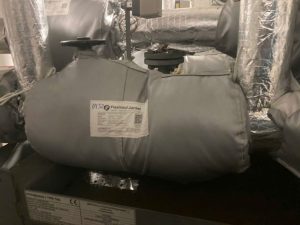An insulation jacket (or insulation blanket) is a flexible insulation solution, custom-designed to wrap around various types of storage tanks, pipes, and industrial equipment. Not only does it help maintain stable temperatures, but this product also plays a key role in saving energy, ensuring operational safety, and extending the lifespan of machinery systems.
What Are Insulation Jackets and Why Are They Important?
An insulation jacket, also known as a removable insulation jacket, is a system of insulation materials precisely fabricated to the shape of the equipment needing protection. They are designed for easy installation, removal, and reuse, offering superior convenience compared to permanent insulation methods like spray foam or mineral wool wrapping.
The role of insulation jackets in industry is critically important, especially for systems involving chemical tanks, oil tanks, boilers, and heated pipelines. They help solve three core problems:
- Temperature Stability: Keeps the medium inside the tank at the required temperature, preventing heat loss to the environment or being affected by external temperatures.
- Energy Savings: Significantly reduces the amount of energy consumed for heating or cooling, thereby cutting operational costs.
- Workplace Safety: The surface of the insulation jacket has a low temperature, making it safe to touch and preventing the risk of burns for personnel working near high-temperature equipment.
The Outstanding Benefits of Insulation Jackets
Compared to traditional solutions, insulation jackets for storage tanks offer many advantages:
- Flexible and Reusable: Easily removable for maintenance, repair, or periodic inspection of equipment without damaging the insulation layer.
- High Insulation Efficiency: Uses specialized materials to minimize heat loss.
- Custom Design: Tailor-made to the exact size and shape of each type of tank, including complex curved surfaces, ensuring a tight fit at seams and joints.
- Comprehensive Protection: The outer shell is waterproof, chemical-resistant, and UV-resistant, helping to protect the inner insulation layer and the tank surface from corrosion.
- Condensation Control: For cold systems, insulation jackets help prevent “sweating” on the tank surface, avoiding damage to equipment and the workshop floor.
- Noise Reduction: Contributes to reducing the noise emitted from machinery operations.
Detailed Construction of a Tank Insulation Jacket
A standard insulation jacket typically consists of 3 main layers, each serving a specific function:
1. Outer Shell
This is the layer in direct contact with the environment, usually made from high-durability materials:
- Silicone Fabric: Heat-resistant, waterproof, and resistant to chemicals and oils.
- Teflon (PTFE) Fabric: Almost completely resistant to chemicals, non-stick, and easy to clean.
- Fiberglass Fabric: Withstands high temperatures and is cost-effective.
2. Insulation Core
This is the most important part, determining the product’s heat retention capability:
- Ceramic Fiber: Withstands very high temperatures (over 1000°C), commonly used for boilers and hot gas systems.
- Glass Wool: Good thermal and acoustic insulation, popular in many industrial applications.
- Aerogel: An advanced insulation material with superior performance, ultra-lightweight and thin, suitable for limited spaces.
3. Inner Lining
This layer is in direct contact with the tank surface and needs to be heat-resistant and non-corrosive:
- Aluminized Fiberglass Fabric: Reflects heat well, enhancing insulation efficiency.
- Stainless Steel Fabric: Used in harsh environments requiring maximum durability and corrosion resistance.
Applications for Tank and Industrial Equipment Insulation Jackets
Insulation jackets are widely used in many industries to optimize processes and protect assets:
- Chemical & Oil & Gas: Insulating chemical and oil storage tanks that need to maintain a stable temperature to prevent solidification or to facilitate chemical reactions.
- Food & Beverage: Insulating fermentation tanks, and tanks for syrup, cooking oil, and chocolate to ensure product quality.
- Plastics & Rubber: Insulating plastic injection molding machines and extruders, retaining heat for molds and screws.
- Boiler & HVAC Systems: Reducing heat loss from hot steam pipes, valves, and flanges.
- Wastewater Treatment Plants: Keeping microbial tanks warm to ensure treatment efficiency during winter.
Selecting and Maintaining Insulation Jackets
To choose the optimal product, businesses should consider the following factors:
- Operating Temperature: The maximum and minimum surface temperature of the tank.
- Working Environment: Is the equipment located indoors or outdoors? Will it be exposed to chemicals or oils?
- Size and Shape: Provide detailed drawings or measurements for the manufacturer to ensure precise fabrication.
- Special Requirements: Is there a need for fire resistance, anti-static properties, or food safety standards?
Regular cleaning and maintenance are also very simple. The surface of the insulation jacket can be easily wiped clean. Thanks to its removability, inspecting the tank surface underneath has never been more convenient.
Investing in high-quality insulation jackets is a smart decision that brings long-term benefits in energy costs, safety, and operational efficiency for any industrial enterprise.
Request consultation and quotation now!Frequently Asked Questions
What temperature can an insulation jacket withstand?
Depending on the materials used, an insulation jacket can be designed to withstand temperatures from sub-zero to over 1000°C.
What is the lifespan of an insulation jacket?
A high-quality insulation jacket can last for many years, depending on the working environment and proper maintenance.
Is installing an insulation jacket complicated?
No. Insulation jackets are designed with specialized straps, buckles, and fasteners, making installation and removal quick and easy without complex tools.
Are insulation jackets waterproof?
Yes. The outer shell of an insulation jacket is often made from waterproof materials like silicone or Teflon fabric to protect the inner insulation layer.
Why use a removable insulation jacket instead of permanent insulation?
The biggest advantage is flexibility. A removable insulation jacket allows for easy removal to inspect and maintain equipment without destroying the insulation, and it can then be reinstalled and reused.
Is the initial cost of an insulation jacket high?
The initial cost may be higher than some traditional methods, but the return on investment (ROI) is very fast due to superior energy savings and low maintenance costs.










